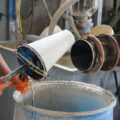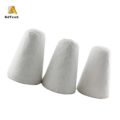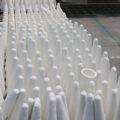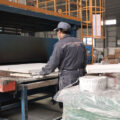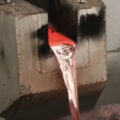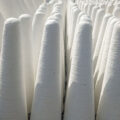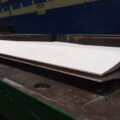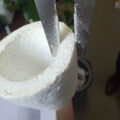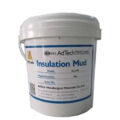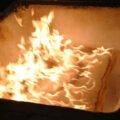Definition of refractory clay
It is composed of refractory powder, binder, and admixture. Ordinary refractory mud made of refractory clinker powder plus an appropriate amount of plastic clay as a binder and plasticizer has low strength at room temperature, and it has higher strength when it forms a ceramic bond at high temperature. The chemically bonded refractory mud, which uses hydraulic, air-hardening, or thermosetting bonding materials as a bonding agent, produces a certain chemical reaction and hardens before the temperature is lower than the formation of ceramic bonding.
The particle size of refractory mud varies according to the requirements of use, and its limit particle size is generally less than 1mm, and some are less than 0.5mm or finer.
The material of the refractory mud should be considered to be consistent with that of the masonry refractory products. In addition to being used as a joint material, refractory mud can also be used as a protective coating for linings by smearing or spraying.
Characteristics and application of refractory mud:
1. Good plasticity and convenient construction;
2. High bonding strength and strong corrosion resistance;
3. High refractoriness, up to 1650℃±50℃;
4. Good resistance to slag invasion;
5. Good thermal exfoliation. Refractory mud is mainly used in coke ovens, glass furnaces, blast furnaces hot blast stoves, and other industrial furnaces. The applied industries are metallurgy, building materials, machinery, petrochemical, glass, boiler, electric power, steel, cement, etc.
Bulk density: 1.8-2.2g/cm3.
There are many kinds of refractory materials, which are usually divided into ordinary refractory materials (1580-1770°C), advanced refractory materials (1770-2000°C), and super-grade refractory materials (above 2000°C) according to their refractoriness; according to their chemical properties, they are divided into acid refractory materials, Neutral refractories, and basic refractories. In addition, there are refractory materials for special occasions.
Adtech mainly produces ceramic foam filter, degassing unit
Refractory mud can be divided into clay refractory mud, high alumina refractory mud, silicon refractory mud, magnesia refractory mud, and so on according to the different composition materials. According to different binders, refractory mud can be divided into the following three categories:
(1) Vitrified bonded refractory clay is a mixture composed of refractory fine aggregate and vitrified binder (plastic clay). The delivery state is dry and needs to be used after adding water. It is hardened by ceramic bonding at high temperatures.
(2) Hydraulic bonded refractory cement It is a mixture composed of refractory fine aggregate and hydraulic binder (cement) which plays the main role of bonding. The delivery state is only dry, and it can be used after adding water, without heating when hardening.
(3) Chemical-bonded refractory clay is a mixture composed of refractory fine aggregate and chemical binders (inorganic, organic-inorganic, organic). The delivery state can be either paste or dry, hardening below the bonding temperature of the ceramic. According to the hardening temperature, this refractory mud can be divided into two types: air hardening and thermosetting. Air-hardening refractory mud is often prepared with air-hardening binders such as water glass. Thermosetting refractory mud is often formulated with thermosetting binders such as phosphoric acid or phosphate. After hardening, this kind of thermosetting refractory mud not only has high strength at various temperatures, but also has the characteristics of small shrinkage, tight joints, and strong corrosion resistance.
There are two types of refractory clay: finished products and semi-finished products. The so-called finished refractory mud is that the raw material and clinker have been prepared in proportion by the manufacturer, and it only needs to be mixed with water according to the standard when used on-site; semi-finished or non-finished refractory mud is raw material and clinker that are not mixed together. When using on-site, fully mix according to the composition of different mud, add water, and stir evenly according to the regulations.


